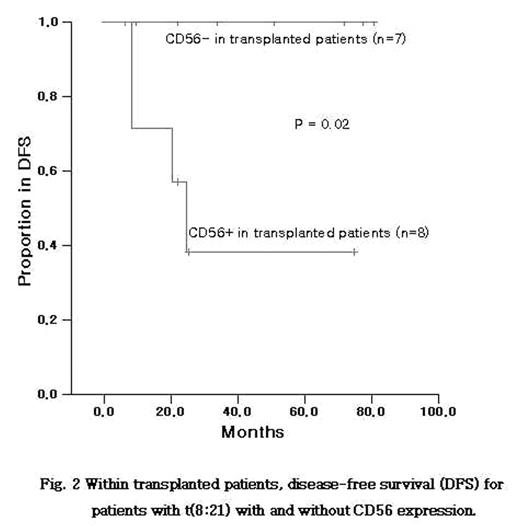Abstract
CD56 expression in acute myeloid leukemia (AML) has been associated with extramedullary leukemia and multi-drug resistance, but the clinical and prognostic significances are not yet clearly defined. Recently, some investigators reported that AML patients with t(8;21) showed more frequent CD56 expression rate and the expression of CD56 antigen adversely affected disease-free survival (DFS). It could explain a diverse clinical outcome in AML patients with favorable cytogenetics. This study investigated CD56 expression in 37 adult de novo AML patients with t(8:21) between November 1996 and June 2005 at three institutions. Immunophenotyping was performed with flow cytometry (Coulter EPICS XL) and considered positive if at least 20% of blasts expressed. CD56 was expressed in 25 cases (67.6%). There was no statistically significant differences in age, sex, leukocyte count, the percentage of bone marrow blasts or the presence of additional cytogenetic abnormalities between the CD56+ and the CD56- group. The complete remission (CR) rate to standard dose cytarabine or N4-behenoyl-1-D-arabinofuranosylcytosine (BH-AC) and idarubicin was similar in both groups (91.7% v 88.7%; P=0.73), but the relapse rate to high-dose cytarabine or allogeneic hematopoietic stem cell transplantation (HST) was quite different (60% v 25%; P=0.08). Allogeneic HST was performed from siblings in 15 patients (40.5%) who achieved CR, 8 patients (32.0%) in CD56+ and 7 patients (58.3%) in CD56- group (P=0.16). The median durations of DFS were significantly shorter in CD56+ (median, 12.2 months) than in the CD56- group (median, not reached) (P =0.02). Also, the median durations of survival showed the same results in the CD56+ group (median, 14.9 months) compared with the CD56- group (median, not reached) (P=0.01). Within fifteen transplanted patients, the median durations of DFS in eight CD56+ patients was significantly shorter than seven CD56- patients (median, 24.4 months v not reached; P=0.02)(Fig.1 and 2).We concluded that CD56 expression was associated with reduced DFS and survival for AML patients with t(8:21) including transplanted patients. Although further larger studies are needed, we suggested that CD56 expression at diagnosis is a predictable prognostic factor in AML with t(8:21).
Disease-free survival (DFS) and Overall survival (OS) for patients with t(8:21) with CD56+ (n−25) and CD56− (n−12) group.
Disease-free survival (DFS) and Overall survival (OS) for patients with t(8:21) with CD56+ (n−25) and CD56− (n−12) group.
Within transplanted patients, decreases from survival (DFS) for patients with t(8:21) with and without CD56 expression.
Within transplanted patients, decreases from survival (DFS) for patients with t(8:21) with and without CD56 expression.
Author notes
Corresponding author



